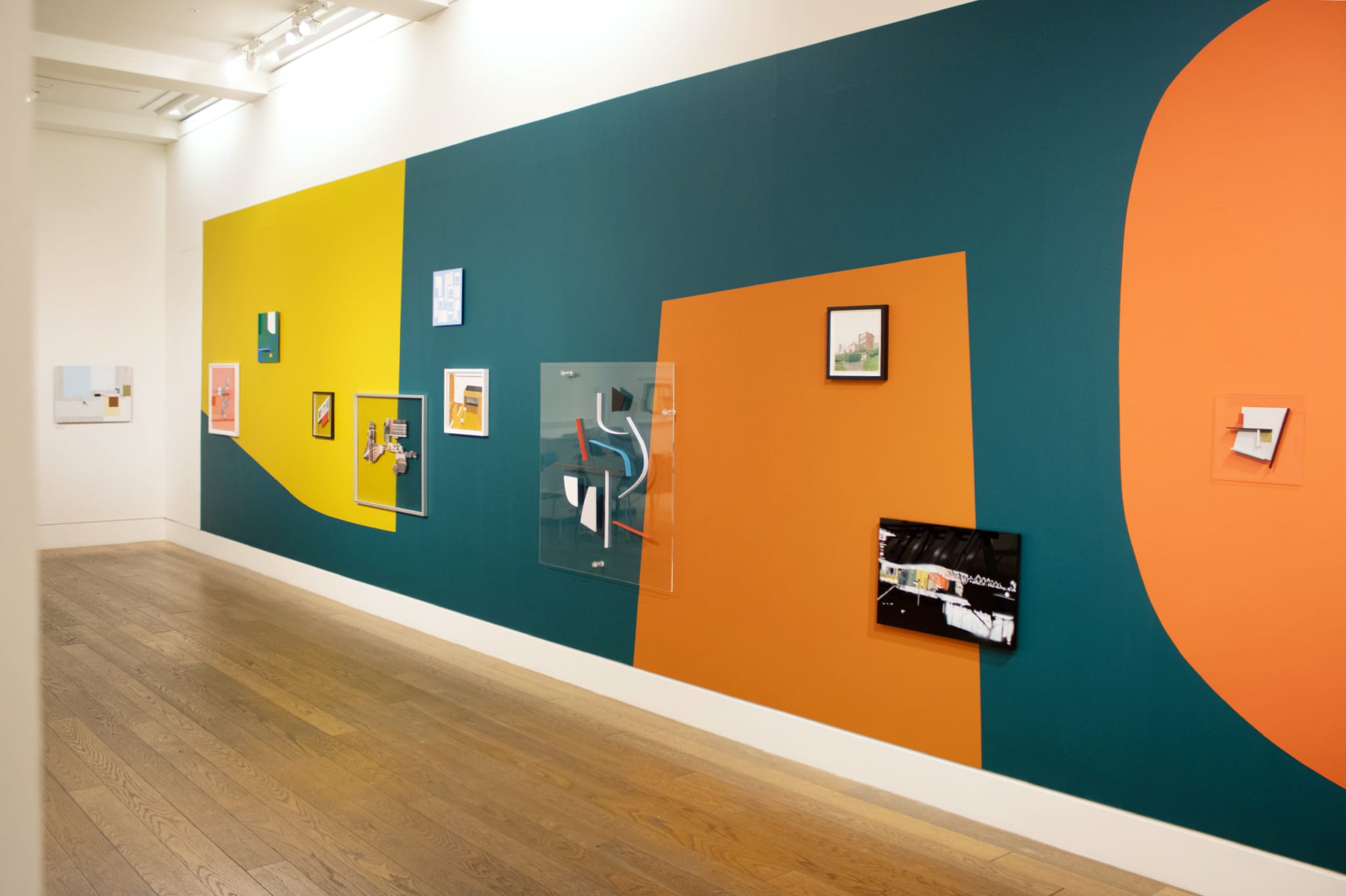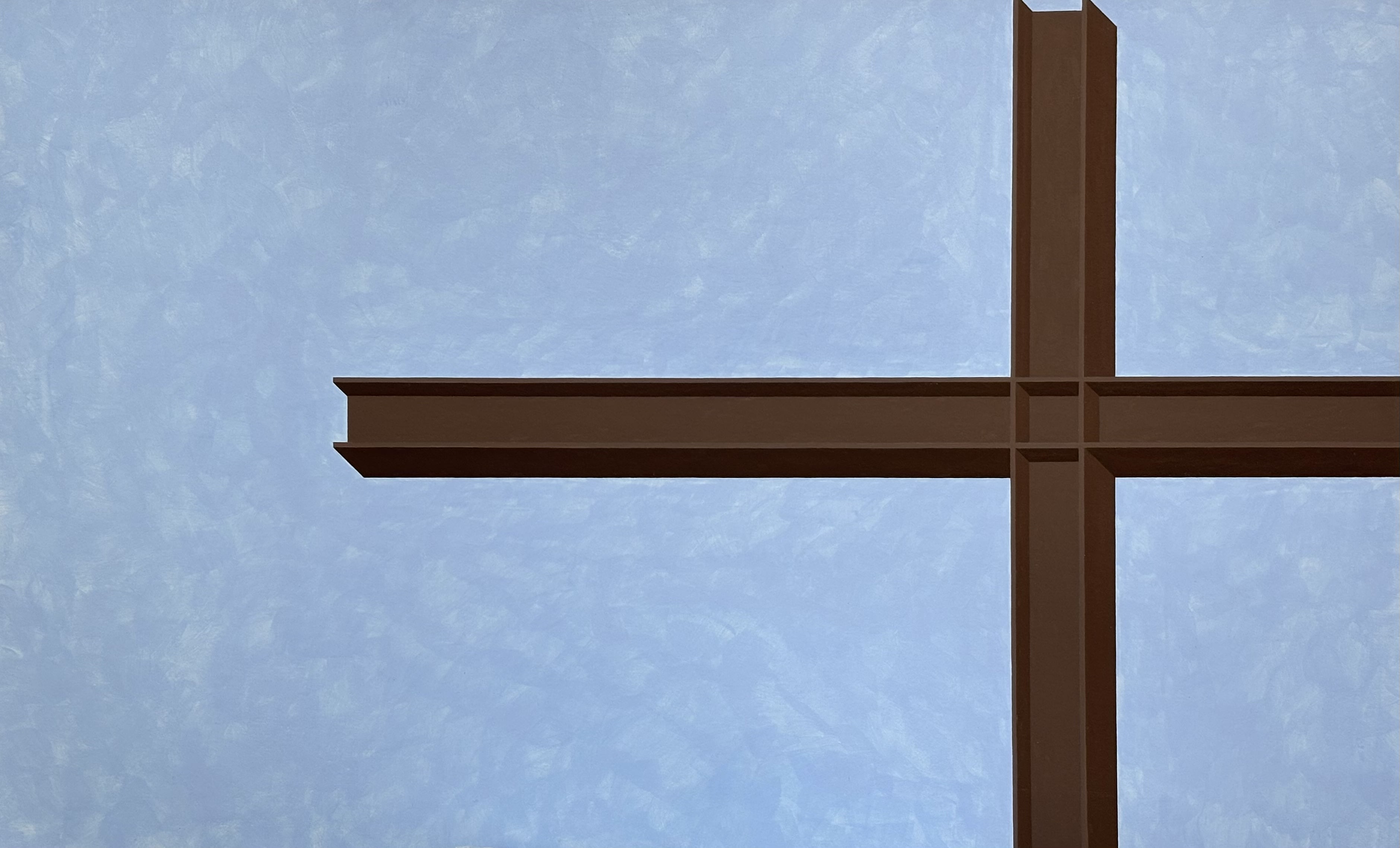
We’re sitting down with our Academicians to discuss their practice, influences and upcoming projects. This month, we're talking to Toby Paterson RSA about the Anderston Centre, the RSA William Littlejohn Award and his relationship with place.
Your new exhibition, A Short Guide to Towns Without a Past, includes a wall painting developed specifically for the Academicians’ Gallery. What does the process of creating a work like this involve for you?
I’ve worked with wall paintings for many years. This approach has something of a dual function, on one hand the production of a discrete artwork and on the other something of an installation device. I always really liked the idea that a wall painting at scale creates something of an analogue landscape that other artworks can sit on or within, allowing the viewer to explore the exhibition space on their own terms in a way the echoes the exploratory processes I’ve undertaken to make the work. There’s always a balance to be struck between the idea behind the wall painting and its existence as a response to a specific exhibition space. This isn’t an a linear process, experience and intention intermingle so I often can’t think back to what the first thought was… In the case of the Academicians’ Gallery I had quite a clear notion about how I wanted to respond to the space both in terms of the extent of the wall painting and in terms of the colour palette deployed.
While considering those questions, thoughts about a reference from memory started to feed me colour ideas, so in that sense this wall painting in particular reflects the developmental processes that underpin a lot of my recent paintings on aluminium, simultaneously their own composition and reflective of a sensory memory. I haven’t made so many wall paintings in recent years, so it was nice to revisit this way of working in a manner that draws some threads of thinking and making together. I really enjoyed making the wall painting and it feels quite dynamic, I hope that energy is adequately communicated to those viewing the exhibition.

Toby Paterson RSA, Crown Circus
A Short Guide to Towns Without a Past spans projects from the last two decades. In presenting earlier works alongside more recent ones, have any themes or questions resurfaced in unexpected ways?
The exhibition is the first in quite some time for me that has taken this varied approach to the types of work exhibited and also when those works were made. There have been a couple of occasions in the past when I’ve been lucky enough to be able to show a wide range of work in the form of a solo exhibition and it is always strangely rewarding to be able to place new works alongside old in a fresh context.
I think what has come out of this process is actually something that reinforces a degree of confidence in my practice because what’s coming to the surface more and more are key formal concerns when it comes to painting, intrinsic elements like colour and shape feeling central to what I do. It’s funny pulling out old works from 20 years ago or more and being surprised that they’re much better than remembered, simultaneously that there are consistencies within the approach to image making. In some ways, the more things change the more they stay the same!
Your work often alludes to specific sites and architecture is a clear influence. Are there places you’ve explored throughout your career that continue to draw you back?
Yes, my work almost always has a relationship with a specific place. There are definitely locations and pieces of architecture that over the years have come to have something of an emblematic presence within my work, things that squat in the imagination in some foundational sort of way. In a sense this is what I’m trying to deal with within my work, things one can’t get out of one’s head. These places are often contentious. There’s something exciting about them in terms of their simultaneous expansiveness of intention and their often melancholy outcomes. In particular, the Anderston Centre in Glasgow has been something of a talisman throughout my entire adult life, beyond even my practice as an artist. I don’t think I’ve ever encountered an urban object so huge that goes so unnoticed or uncommented upon! It presents such an inventory of extraordinary spatial and formal experience and its history is so challenging the entire bodies of work could be built around it. The first work I made in relation to it was done about 25 years ago and the engagement with the pathos of this place has resulted in all sorts of different responses from small works on paper up to an immersive concert and exhibition event a decade ago, in collaborative partnership with the Scottish Ensemble. As muses go, the Anderson centre is probably quite an unconventional one!
I think I’ve had a similar relationship with a New Town of Peterlee in County Durham, it’s certainly had a huge impact on how I think about the relationship between painting and architecture/urban development. Peterlee has such a rich story that it seems almost fictional, that Victor Pasmore and abstract painter could end up having such a extraordinary influence on the development of this place. While the outcome of its development might not ultimately have been terribly successful, it’s such an extraordinary notion that a place with such a history exists in the UK, it’s endlessly fascinating to me.

Toby Paterson RSA, Talisman, 2014
You received the RSA William Littlejohn Award in 2025 for excellence and innovation in water-based media. What have you been developing since receiving the award?
I was delighted to receive the Littlejohn Award. I’ve worked almost exclusively with water-based media since the late 1990s, realising retrospectively that all the work I made in oils while studying at Glasgow School of Art was simply me trying to get that medium to behave like acrylic! I feel very comfortable with this medium regardless of the way that I’m employing it, but it’s really important to continually try to evolve material methodologies and not to get stuck in a rut.
The objective of my proposal for the Littlejohn Award and this current exhibition at the RSA are inevitably pretty closely aligned and the first works completed under the auspices of the award are included in the exhibition, namely Unfolding Premonition, Newton Street and Relic Fragment. These paintings are the first in a series of studio works refocussing on my particular interest in points of spatial, social and infrastructural connection as experienced in a quotidian way, things that are components within grand plans that are now obsolete. In the context of Glasgow specifically, it’s the case that many things that were intended to drive connection now seem to represent disjunction or severance, the constituent parts feeling vestigial or surplus despite their centrality within the city’s geography. In many ways, these remnants represent Robert Smithson‘s nostrum of cities ‘rising into ruins', calling into question how we go about envisaging the future of the places we inhabit from the context of the present. I guess in my own small way this is something of an exercise in time-based landscape painting…

Toby Paterson RSA, Relic Fragment, 2025
When new Academicians are elected, they each submit a work to the RSA Diploma Collection. Could you tell us about your Diploma work, Station Stairs, and why you chose it to represent your practice?
This work was one of a series of large paintings on Perspex made for my expansive 2005 solo exhibition After the Rain at the Barbican in London. Derived from research trips to the reconstructed cities of Hamburg, Rotterdam and Coventry, that exhibition meditated on the persistent resonance of places reimagined following traumatic historic events. Originally exhibited as an element in a large-scale installation involving multiple individual paintings and sculptural and photographic works, Station Stairs was integrated into an environment defined by a 100 metre long wall painting and numerous three-dimensional sculptural display structures.
This project was an important one for me, both in terms of its artistic approach and its personal significance. After the Rain further refined and established at scale the research and making methodology that formed the basis of my painting practice for the next decade or so. Elements of this way of working and thinking persist in how I still work now, (not least in the current show) but Station Stairs is from the time when I was right in the thick of grappling with the spatio-political legacy of the post-war settlement and its place -or otherwise- in 21st Century life. The work is also representative of a period of notable technical and material evolution with regard to my approach to image making, incorporating new supports and painting and framing techniques that play with reflection and transparency. It is also the first work that marks my shift into the exclusive use of Swiss manufacturer Lascaux’s superlative paints.
This painting in particular relates to the poignancy of public infrastructural form, in this case the circulation spaces at Coventry’s 1962 central railway station. It was a keynote work in the ensemble exhibited at the Barbican in 2005 in that it presents an idealised image of a quotidian space in an effort to make my subjective concentration on it palpable while, simultaneously, proposing that there is potential inherent in a broader engagement with the form and meaning of one’s everyday surroundings. It’s a great example of a work from earlier in my career whose ethos still has a resonance with what I’m doing now.
Explore Toby Paterson: A Short Guide to Towns Without a Past in the Academicians' Gallery from Saturday 24 October to Sunday 23 November.

